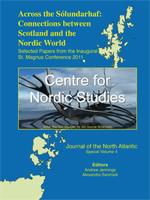Until recently, the idea of large-scale Viking settlement in Scotland's Inner Hebrides was considered unlikely. Despite a conspicuous absence of documentary evidence, the area's long-standing Gaelic heritage was seen as proof of linguistic and cultural continuity from its Dalriadan heyday. By developing the narrative to consider other types of evidence, however, it is clear that the Norse impact on these islands was far from insignificant. This paper will review the historical record in the light of material evidence and linguistic artifacts such as place-names. After questioning aspects of currently popular approaches to “predatory” migration, it will then examine how reappraisal of the practicalities of Viking Age immigration might help to inform a revised model for Norse settlement in the region.
BioOne.org will be down briefly for maintenance on 17 December 2024 between 18:00-22:00 Pacific Time US. We apologize for any inconvenience.
How to translate text using browser tools
1 October 2013
Modelling Viking Migration to the Inner Hebrides
Alan Macniven
ACCESS THE FULL ARTICLE

Journal of the North Atlantic
Vol. 2013 • No. sp4
2012-2013
Vol. 2013 • No. sp4
2012-2013




